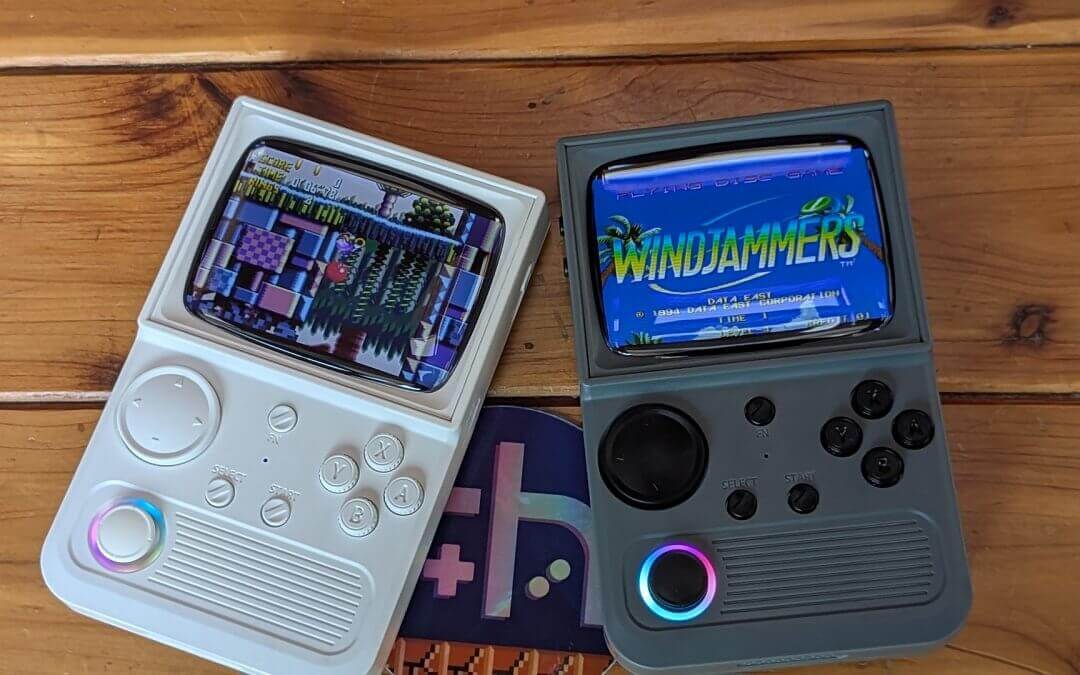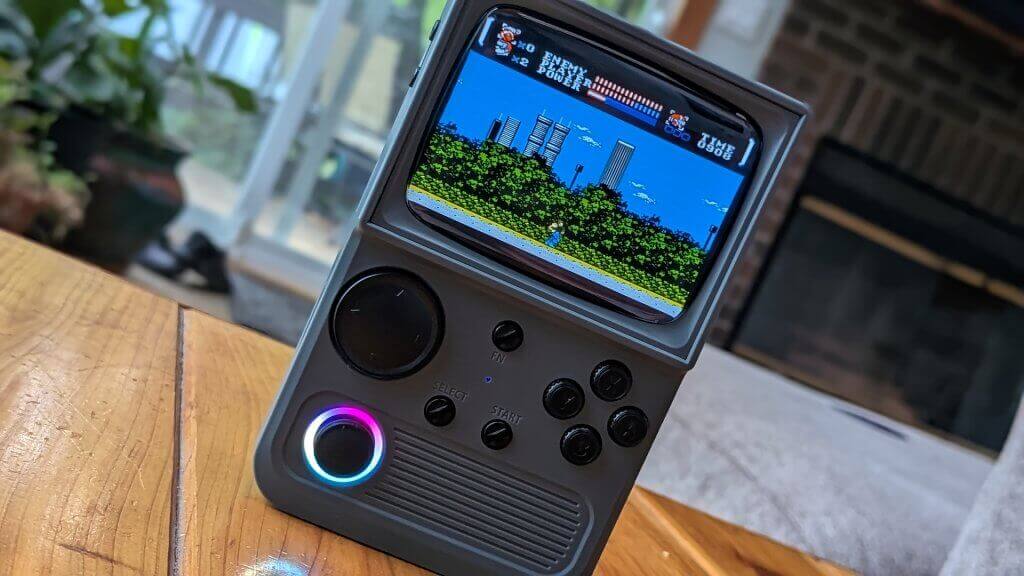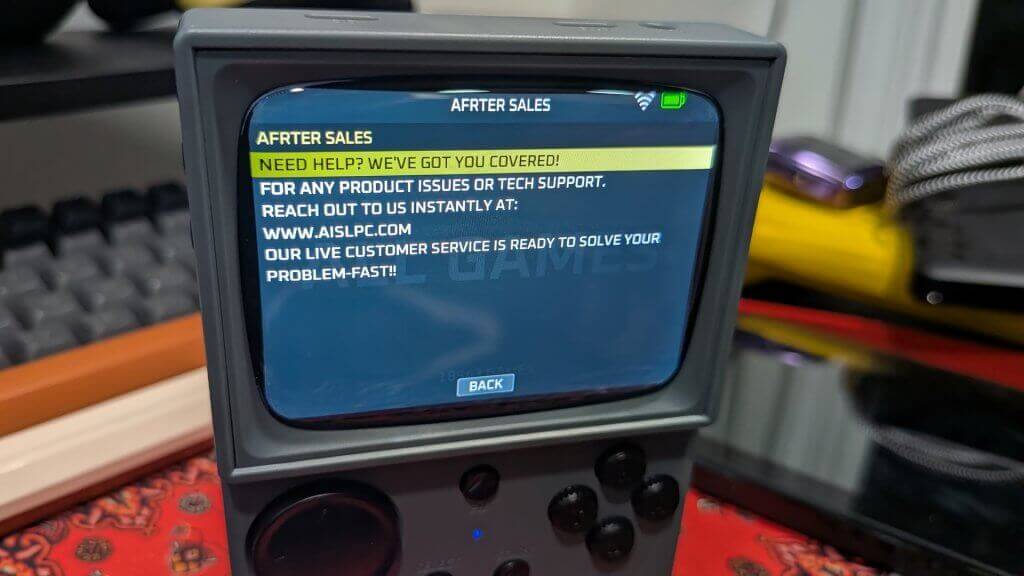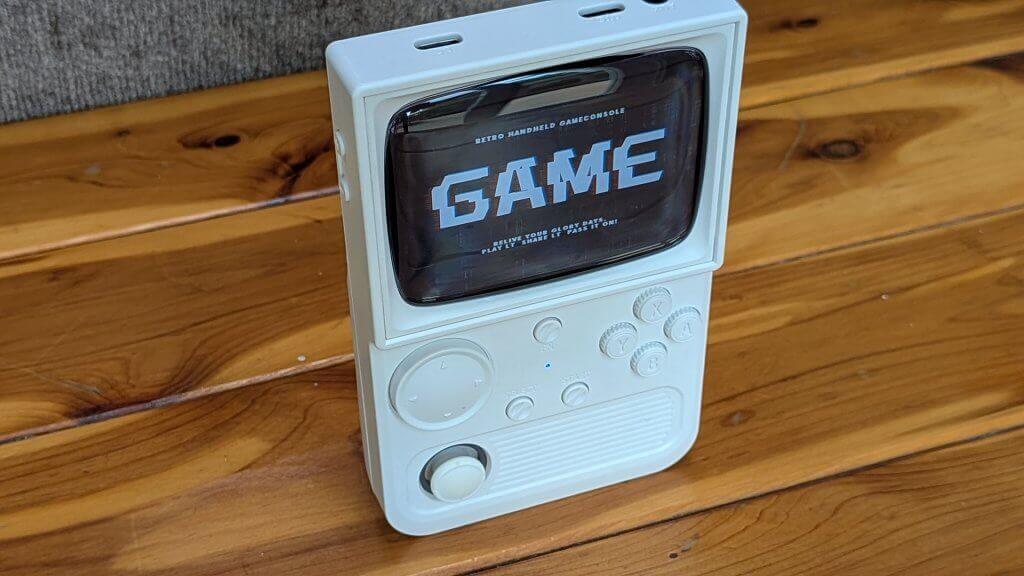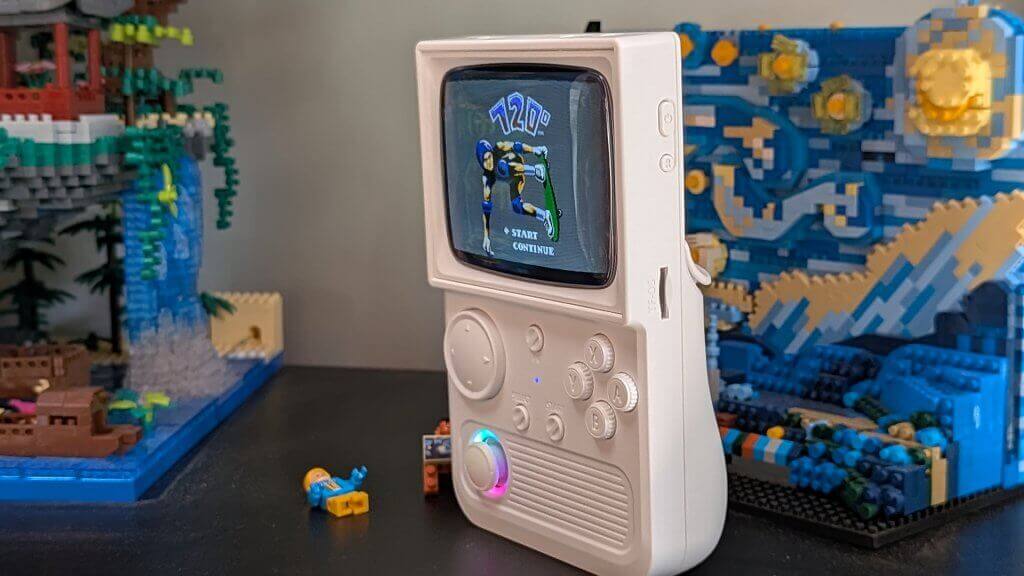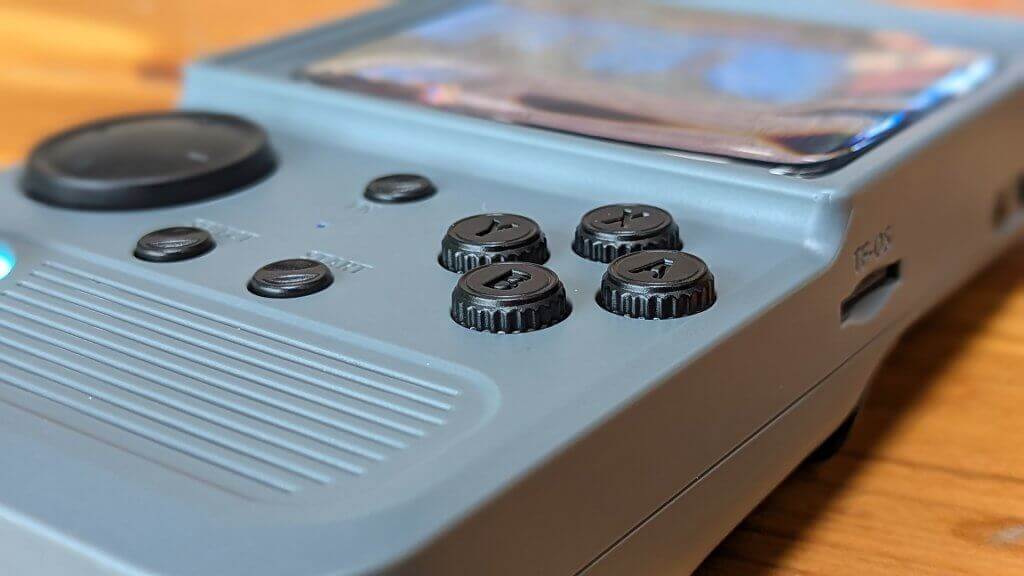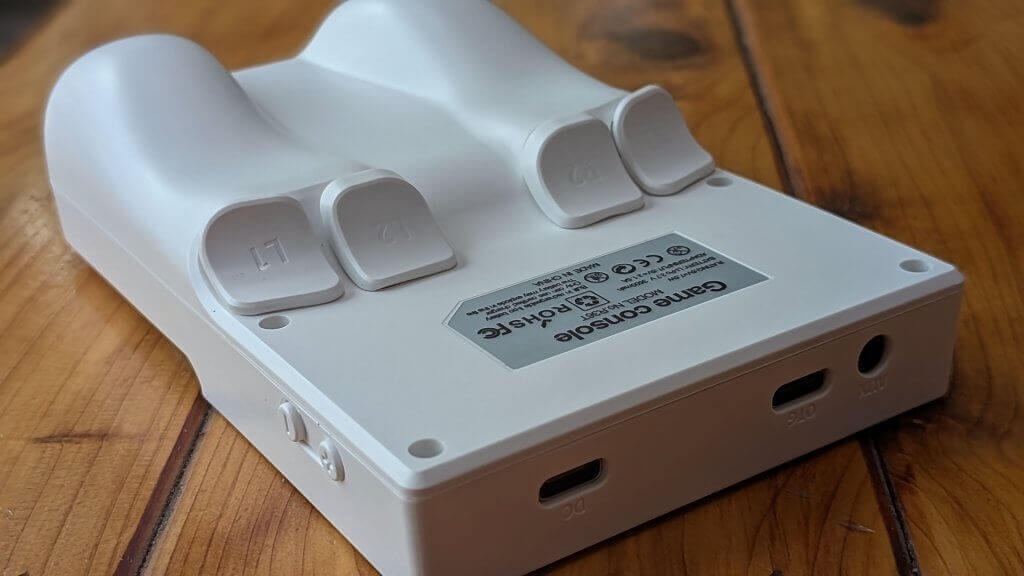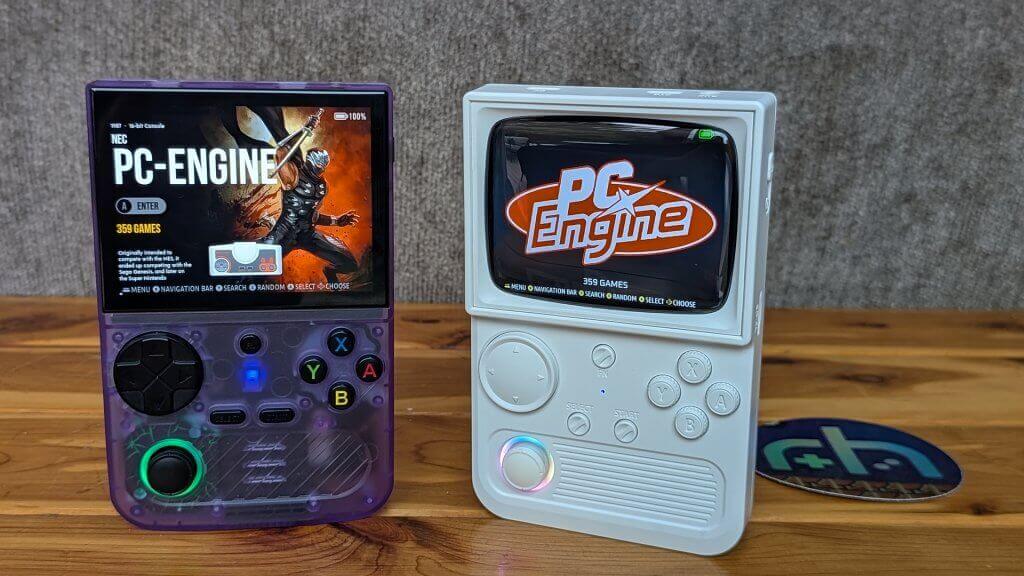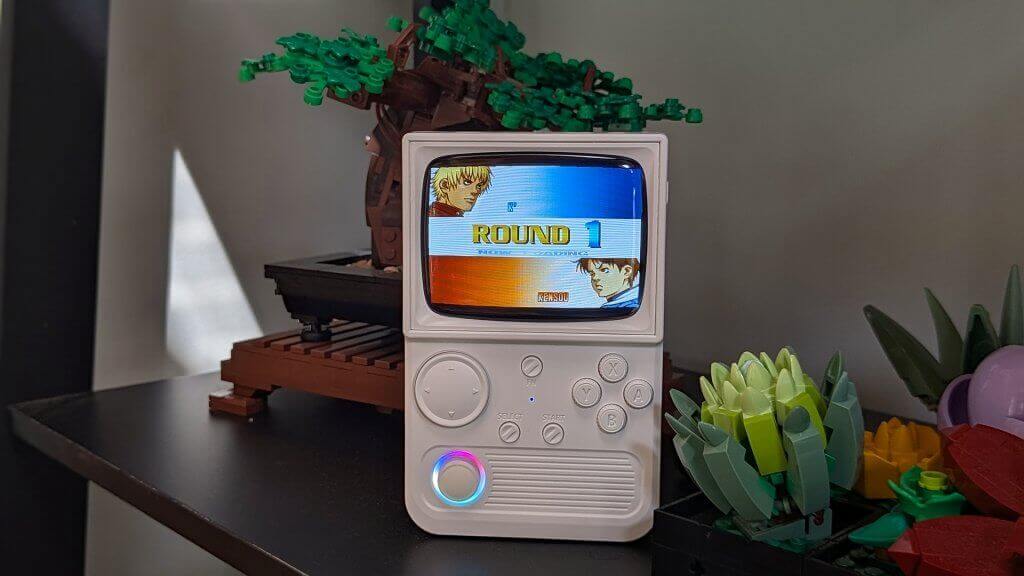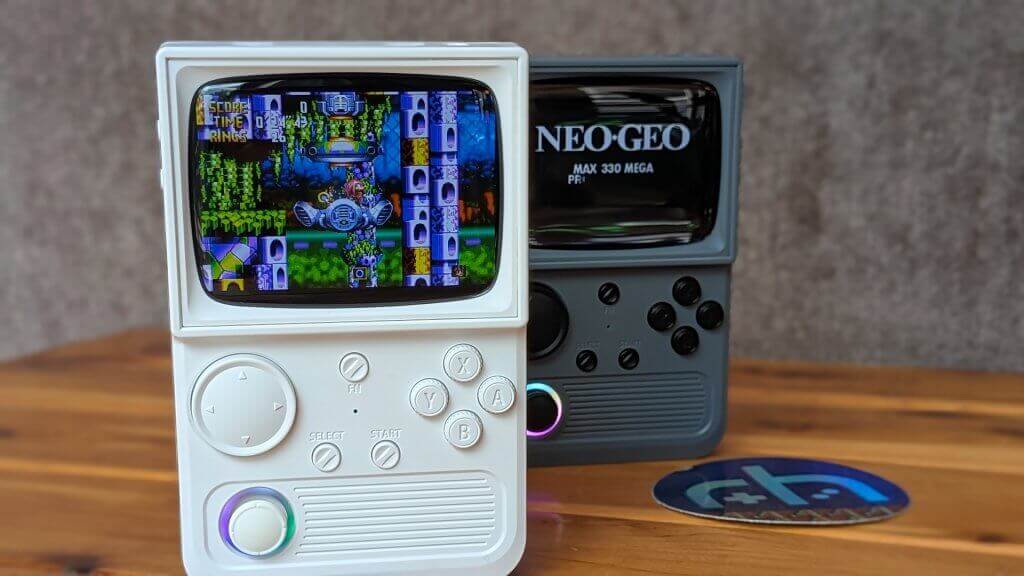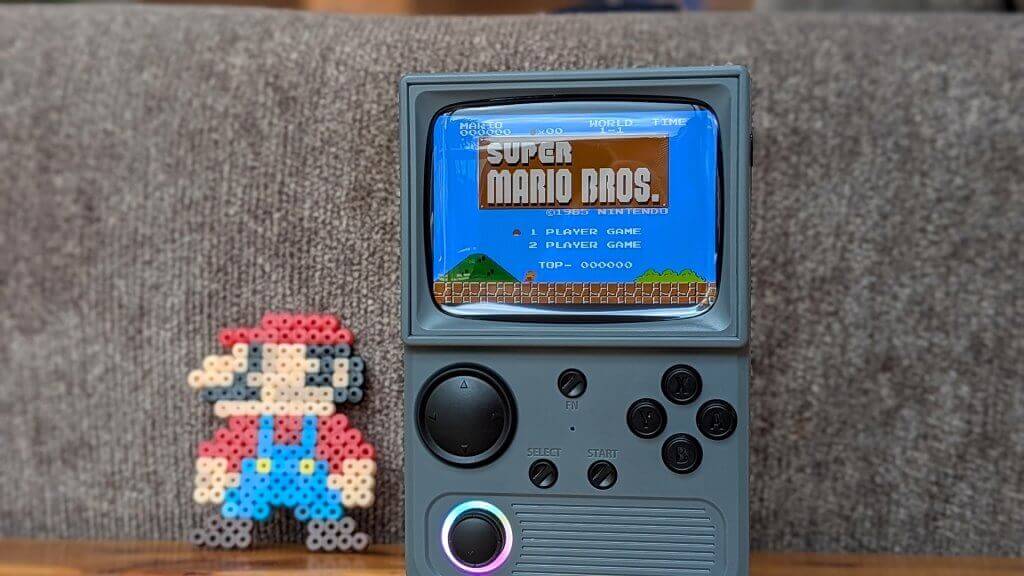I couldn’t quite place what felt so familiar about the Game Console R36T at first. It wasn’t until I did some digging through my beloved clone console collection that lightning struck. This is just the funky version of the K36 that I’d reviewed a while back, now in a shell that makes no bones about its retro roots. In that article, I’d said that while there was nothing particularly wrong with that version of the K36, it didn’t really make any sort of argument for itself.
In a sea of clone consoles, it just sort of was. Neither rising above the fray to the surface, nor sinking to the depths. The R36T certainly attempts to rectify the K36’s lack of ability to stand out from the masses. If the K36 was just another generic device, the R36T proudly separates itself from the pack, refusing to be ignored.
Game Console R36T Specs
The specs on the R36T are nothing remarkable if you’ve been around the handheld emulation block, but it is certainly nice to see Wifi included as a standard feature now in most budget offerings.
- CPU: Rockchip RK3326
- GPU: Mali-G57 MC1-2EE
- RAM: 4GB
- Screen: 3.5″ 640×480 Screen with CRT bubble cover
- Battery: 3500mAh
- Connectivity: USB-C x2, 3.5mm Jack, Micro-SD, Wi-Fi, 16GB eMMC
- Operating System: Custom Linux
- Weight: 195 grams (according to my kitchen scale)
- Colors: White, Black
R36T at Amazon R36T at AliExpress
Game Console R36T Design
Clearly, the biggest talking point surrounding the R36T will be its design and housing. The unique retro effect on the screen is achieved not through some micro-manufacturing miracle of classic Cathode Ray Tubes (which would be nearly impossible logistically in 2025), but just through some bubble-domed plastic trickery.
The intended effect actually works quite well, so long as you’re staring more or less head-on at the handheld. Angled photos can show that the screen cover can produce odd shots at angles, but it’s unlikely to negatively affect the user in the realm of normal everyday play.
Units for this review were sent from AISLPC, and to their credit, they are the first manufacturer/dealer in this space that I can recall providing customer support instructions from the EmuElec menu. We, as the handheld enthusiast community, should take a step back on occasion and realize that we may be a little too close to the hobby sometimes.
Your average consumer off the street could well be intimidated jumping into this entirely unfamiliar world, and it’s encouraging to see a company step forward and offer a hand to those who might need it. And if that’s not your thing, there’s still always the RH Discord community to turn to if you’re struggling.
That Screen
So it’s important to note right off the bat, and I will repeat this point, because I’ve seen some confused comments out there. This device in no way has anything to a CRT display. This is a convex, bubbled piece of plastic, made to replicate the experience of playing a curved CRT. The display is likely the same as that that appears on the more traditional K36. If you had hopes of a small manufacturing miracle, I’m sorry to be the one to dash them.
When I was a kid, my dad won a Sony Watchman as a door prize at his company holiday party. This little black and white beauty was a technical marvel for a kid like me in the late 80s. While the 36T doesn’t perfectly recreate that experience, it does a noble job of capturing its spirit.
And let’s be honest, it’s not like you could really do any gaming on a Watchman without some serious effort, so I’m on board with it being something of a compromise. The Watchman series used “pocket TV CRT” technology on a recessed screen. Sadly, as there is no longer any demand for manufacturing of any of the needed parts, it simply isn’t feasible to recreate in 2025. Not without significant expense, anyway.
The nature of the curved screen cover means that the bezel is going on. Users will notice bars across the top/bottom of the screen, as well as on the sides. Whether this might be a dealbreaker will have to be up to you. I didn’t find it too jarring, but it might depend on what title you decide to fire up.
Unfortunately, the curved CRT effect does come with some drawbacks. Glare in bright rooms does have a tendency to reflect off the curved corners of the screen bubble, and viewing the screen from any sort of angle can feel strange.
Having said all of that, I think the designers have achieved the intended effect of replicating the displays of old without trying to do the impossible. The screen’s imperfections are drastically improved by applying a CRT filter of your choice, but more on that later.
Ergonomics
To put it bluntly, if the K36 and its curvaceous back end weren’t for you, then the R36T probably won’t be either. It’s the same design as before, and while I find that resting my index fingers on the triggers and middle fingers across the interior of the back curves, I can understand where some people might find the experience to be a bit cumbersome. I have longer fingers that contour well around the device, but you’ll have to try one to see if it fits your preferred play style.
Controls
Besides the glaringly obvious difference of the large bubble covering the screen, the controls on the R36T are what make it stand out from the clone pack a little more. These choices seem intentional to separate the R36T from the rest of the cloned pack, but the consideration was clearly made to try and be visually different and appealing first, rather than implementing the best possible controls for the form factor.
Pad & Stick
One look at photos of the R36T, and you can immediately see that this is not your standard D-pad. The circle pad used here has a smooth, domed design with only four tiny arrows in each major direction serving as texture. It’s totally unlike anything I’ve really used in a retro handheld before.
As much as I’d expected it to be something of an unusable mess via photos, I was impressed by how well it actually functions in practice. Somewhat surprisingly, I was able to continuously chuck out fireballs without issue. Would it be my first choice for controls, either here or on another device? No, I don’t think it would. But this handheld is clearly trying some things outside the box, so why not dive all the way in?
I’d imagine the inspiration for the circle pad is the knob on an old rabbit-eared console TV. The whole effect would be better achieved if we had something a little more of the era in terms of shell colors. White on white is great for sleek Ayaneo devices or something like the RG40XXV, but it feels out of place on a design that’s supposed to hearken back to the 80s and watching a television that was meant to match the rest of the wooden furniture, sitting cross-legged on the carpet.
The single analog stick on the device is the same Switch Joy-Con stick we’ve seen on countless devices before, including the K36 that came before this one. They’re functional and served me well in the parts of the PSX/DC/PSP library offered with the R36T. The small LED around the analog stick keeps things fun, though without the fun cracked plastic effect of its predecessor.
Buttons & Triggers
Face buttons on the R36T are a bit different, and do stand out when stood up against the existing R36 fleet. I’m not sure that they benefit from the texturing around the sides of each button. I can’t say for certain that my thumb ever really felt any difference. The design helps the R36T stand out aesthetically, but any difference in play feel is fairly unremarkable. That is to say, the buttons are here and functioned just fine in my testing.
And speaking of button functions, I hope you liked those loud clicky triggers from the K36 and OG versions of the R36S, because they’re well represented here. The R1-R2/L1-L2 triggers on the R36T click against the nearly hollow plastic shell and create something of a minor reverb through the handheld. They are functional and work just fine, but I think you’d be hard-pressed to find anyone who prefers these old clackers.
Sound
Audio of the R36T comes from a single down-firing speaker, but that’s not to say that it doesn’t get loud. The additional room on the rear-end of the R36T, like the K36 family of handhelds that came before it, creates something of a cavernous audio experience that gives the small speaker the illusion of being more powerful than it otherwise might be. It was fine on the handhelds that came before it, and it’s just as fine now.
I did have a few distorted pops and crackles when trying out some of the more demanding PSP titles like Vice City, but I put that down more to limitations of the hardware being pushed by the emulator. Outside those few minor hiccupped occasions, the device performed fine in the audio department throughout my testing.
Software & Presentation
The R36T came with a stock SD card loaded with a custom Linux ROM with the EmuElec frontend. The stock experience should be familiar enough to those who have played around with similar devices in the lineup. It’s a decent jumping point, and I’d assume that, given the ubiquitous RK3326 under the hood, additional CFW options should be on the way, given enough time and members of the community getting their hands on the device.
I’d have thought that, given the R36T’s design inspirations, and going so far as to have a curved bubble over the screen, that CRT filters would make sense in the emulated games. In something of an odd choice, the designers have opted to just display the games in the same way they’d be seen on more conventional handhelds.
The handheld is clearly aiming at an audience that’s romantic over the displays of the past, so why not nudge it a little further into the theme? It seems an odd choice not to offer this out of the box to a consumer who may not even know that shaders, overlays, and the like are even an available option.
This is, of course, entirely fixable by the user within the basic menu options already included on the device, but it might have been nice to have things already set up for those of us who aren’t quite as experienced in emulation. It strikes me as counterintuitive to design everything around a mock-CRT experience and then leave the filters turned off in the software. Again, a minor gripe considering how easy it is to fix, but it might have been cool to see what the devs thought worked the best for the handheld.
Is It Worth It?
I’ll be entirely honest here. Even as someone with a major soft spot for devices in the R36 family tree, I was skeptical that the R36T could be anything more than a novelty. And while it is certainly something of one, I do think that there’s enough here to warrant additional consideration.
One look at the AISLPC website tells us that these are likely the folks who gave us the R36MAX, and the MyMini. Either that, or they are really large fans of distributing devices that are designed to be a little wacky. That said, I wish kitsch translated across the seas a little better. Some fake wood paneling would really go a long way to endearing me further to the device.
While the device is not one I’d recommend as a first foray into emulation, users who have already been around the handheld block once or twice could find something fun to love. Recently, I wrote about the term “e-waste” and how it’s often unfairly applied to many budget devices in the space.
The R36T is doing everything in its power to test that hypothesis. It has no real reason for being, and yet here it is for us to play with. It’s a curiosity that hopefully comes with a price tag low enough to warrant scratching that curious itch. In that regard, I’d call the R36T a success.
So if you’re on the lookout for something that may not set the world on fire, but will certainly stand out from the pack in your collection as one of the more interesting offerings in a very crowded space, then the R36T might be worth your consideration.
There’s some fun personality on offer here, and while it may not be perfect, it may still allow a generation of gamers the closest approximation of classic console TV gaming that they’re ever likely to have, and if that allows for the making of some of their own memories, isn’t that what we’re all here for?
R36T at Amazon R36T at AliExpress
What did you think of this article? Let us know in the comments below, and chat with us in our Discord!
This page may contain affiliate links, by purchasing something through a link, Retro Handhelds may earn a small commission on the sale at no additional cost to you.
